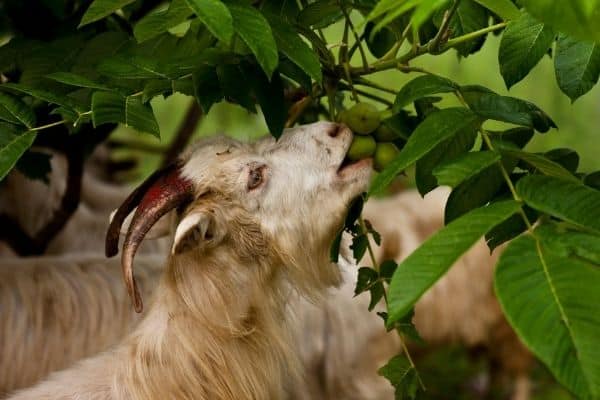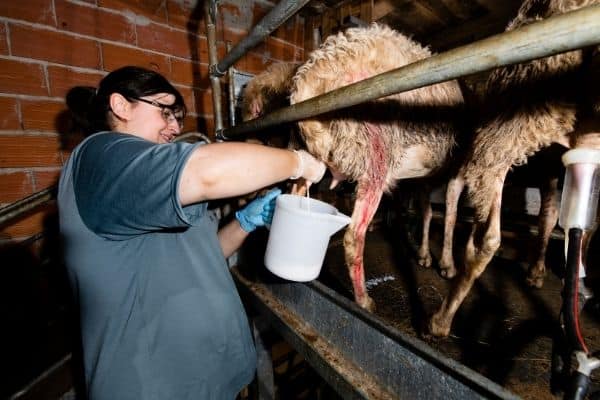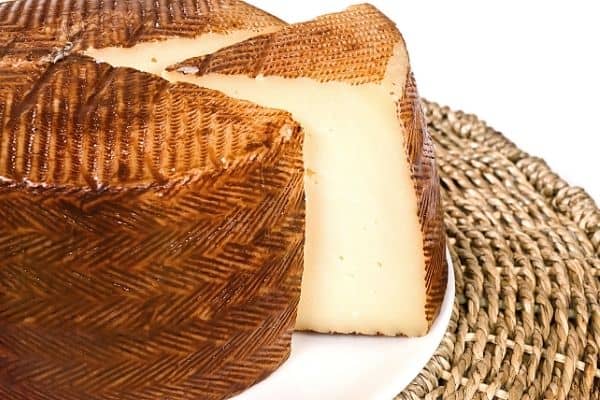What’s not to love about a long cool glass of creamy milk? OK, maybe you’re someone who can’t stand the stuff, but the benefits of milk have long been known for healthy bone growth and general good health. Unfortunately, some people cannot consume good old cow’s milk. This is due to the inability to digest it properly or because of an allergic response to it.
According to our research, the average figures for milk production for a dairy goat would be 2.5 liters per day, and a sheep would be 2 liters per day.
Well, Goat and Sheep milk are two wonderful alternatives to cow’s milk that are both delicious, have their own unique health benefits, and can also be used to make cheese, yogurt, cream, and even butter. Yes, the playful goat and the smiling sheep can provide us with this wonder of nature too and are indeed a lot smaller and easier to handle than a cow!
When it comes to deciding whether goats or sheep are better for milk production, there are several things to consider. So if you are thinking of keeping your own animals for milk, several things need to be assessed. How much land do they need? Which is the cheapest and easiest to keep? Which is the easiest to milk? Which one produces the most milk out of these two much-loved animals?
We answer all these questions below to help you decide whether goats or sheep are better for milk production.
Goats vs. Sheep: How Much Land Do They Need?
Although these animals are easier to keep than other livestock, they still present their own challenges. One of the first things to consider is how much space you have available and what sort of land it is.
Sheep are grazers and require a lot of grass that they can happily munch away on all day long. On the other hand, Goats are browsers meaning they like to eat things at head height, such as shrubs, bushes, and twigs. They will also eat weeds which can be quite useful. So you can see it is important to assess the food available to them on the land where you are thinking of keeping them.
Also, the climate and growing conditions where you live are very relevant. If you live in a cooler climate where there is a lot of rainfall, for example, you will have a lot of the natural pasture that sheep love to graze on, and therefore you could keep more of them per acre. If, on the other hand, you live in a climate that sees prolonged hot, dry periods that reduce the land to a parched yellowy-brown, then the number of sheep per acre will reduce significantly.
Goats can deal with drier, arid conditions as their diet is more varied. They can make a meal from the scrubbiest, rough, dry land and will even eat your laundry on the line if you’re not careful! But let’s face it, polyester and cotton will most likely not provide the best milk!
The type of land is also significant as this will ascertain how much you will have to pay out to supplement their diet with hay, etc. So if your land is really shrubby with lots of bushes and weeds to provide your goats with, the less you will have to spend on food. In the same way, if you have an abundance of lush green pasture and decent rainfall, you will spend far less on buying extra feed for your sheep.
Goats do not particularly like to eat from the floor as they much prefer to browse plants at head height. So if you have to feed them hay, always use a manger or some other form of the holder to keep it off the floor so they can pick and pull away at it. It also keeps the hay dry rather than ending in a damp, inedible pile on the floor.

So how many sheep or goats per acre is not a simple answer. It’s always a good idea to discuss this with your local agricultural department, who will advise you according to the climate and land in your area. Or have a chat with a local farmer who keeps sheep and/or goats.
Goats or Sheep: Which Are Easier to Keep?
Goats are known to be great escape artists and so need to be fenced in VERY securely. They have also been known to open locks on gates, so you need to get a goat-proof latch! Also, make sure you do not have any obstacles near the fence that they can use to jump over!
The last thing you want is an angry neighbor at your door complaining that your cute goat has wiped out their whole supply of fruit and vegetables that they have been lovingly cultivating! Or decided to head-butt or tap dance on their car – trust me, this does happen!
But in the goats’ favor, they are generally easier to handle than sheep. This is really important as you need to look after these animals with routine maintenance such as hoof trimming, shearing, vaccinating, and worming. Sheep are far more likely to bolt and are a real pain to catch once they get scared, whereas a goat will usually be quite compliant and allow you to secure them with a rope.
Looking for Shearing Machine for your Sheep?
Check best Sheep Shearing Machines under $200
Sheep tend to suffer from fewer diseases and birthing issues than goats and are slightly hardier with different climates. They don’t mind rain and wind as much as goats, who need to be provided with adequate shelter from these elements. Sheep will find shelter under a tree, but goats need to have something a bit more robust, even if it’s just a 3-sided shelter to keep out the wind and rain.
Which Are Easier to Milk – Goats or Sheep?
Sheep tend to have smaller teats and so are slightly more difficult to milk than goats. Also, because sheep are generally timider than goats, it is important to try to bond with them from a young age and get them used to being handled, so they don’t run away every time you try to milk them. Once this is the case, they are pretty simple to milk.

Goats are also fairly easy to milk once you get used to milking them. Goat milking can be done either by hand or with a small, handheld battery operated machine. But with either of these animals, there is a risk of kicking, so beware! In either case, you will need to have a milking stand – store-bought or homemade – to secure them whilst you milk them.
A nice bowl of their favorite treat food is a good way to keep them calm during this process. They also like routine and order, so make sure you milk them at the same time every day and in the same order of animal. Pretty soon, you will enjoy seeing them jump up onto the milking stand by themselves as they learn the order of play!
Goats or Sheep - Which Produce the Most Milk?
So this is very much dependent on the type of breed. You can get very large breeds or really small breeds, and of course, their milk yield will be dependent upon this. Having said that, a small pygmy goat can yield 2 liters per day, which is surprising given their small size. Also, as mentioned before, it is dependent on their pasture or food source, but an average figure for a dairy goat would be 2.5 liters per day, and a sheep would be 2 liters per day.
Which Produce the Best Milk – Goats or Sheep?
This is an important question! First up, let’s take a look at the nutritional comparison table below to see the main differences:
PER 100g | GOAT MILK | SHEEP MILK |
|---|---|---|
Calories | 69 kcal | 108 kcal |
Fat | 4.1g | 7g |
Protein | 3.6g | 6g |
Carbs | 4.5g | 5.4g |
Calcium | 134mg | 193mg |
Magnesium | 14mg | 18mg |
Potassium | 204mg | 137mg |
Phosphorus | 111mg | 158mg |
Zinc | 0.3mg | 0.5mg |
Iron | 0.1mg | 0.1mg |
Vitamin C | 3.2mg | 10.3mg |
Vitamin A | 139.1ug | 107.8ug |
Vitamin B6 | 0mg | 0.1mg |
Vitamin B12 | 0.2ug | 1.7ug |
Folate | 2.4ug | 17.2ug |
So we can see that sheep’s milk has the densest nutritional profile. Still, apart from looking at the health benefits, it does all come down to personal taste.
With sheep’s milk having higher fat, protein, and carbohydrate levels, it will pack a much creamier, sweet-tasting punch and is undoubtedly the favorite in our family. But of course, if you want to keep your fat consumption to a minimum, this may not be the best choice for you unless you reduce the amount that you use.
Another important thing to note about goat and sheep’s milk is that they are both naturally homogenized, which is one of the key factors in making them more easily digestible.
Other Uses for Goats and Sheep Milk
Cheese
Just like cow’s milk, goat and sheep milk can both be used to produce some wonderful cheeses. In fact, most commercially produced sheep’s milk is used to make cheese all around the world. France produces the wonderfully creamy Roquefort; Greece produces gorgeous tangy feta; Italy the infamous Ricotta and Pecorino Romano, and in Spain the highly-prized manchego.

Manchego Cheese
Goat’s milk is also used to make many tasty cheeses, including feta, halloumi, chevre, and Anejo, to name but a very few. So you can see that both kinds of milk are well-suited for cheese-making and every country has its specific cheeses.
Yogurt

Both goat and sheep milk are used to make yogurt. Most of us are familiar with the wonderfully rich Greek yogurt, which can be made from either type of milk and usually differentiated by its texture and tanginess. The Greeks used to make yogurt with the leftover sheep’s milk from cheese making.
Cream
The cream is produced from both goat and sheep milk, but it is not easy to separate the cream from their milk due to its naturally homogenized state. The best way is to chill the milk for a few days and then skim the cream off daily over the next week.
Ice Cream
Oh yes- you can make wonderful ice cream from both of these kinds of milk too! Using a combination of their milk and cream, you can create a huge variety of homemade ice cream for all the family to enjoy. Even those with cow’s milk intolerance can enjoy this much-loved sweet treat, instantly catapulting you firmly to numero uno in the popularity stakes!
Butter
You can most certainly make butter from either of these milk, although it generally takes a lot of milk to yield a little butter. It’s a matter of separating the fat from the cream you skimmed off, and this is done by whipping it. You can then add salt and/or any flavorings that you like to make it unique. How satisfying to be able to eat butter that you have produced yourself!
Conclusion
So you now know pretty much all you need to decide whether, for you, goats or sheep are better for milk production. Depending upon the type of breed, their environment, and food source, these amazingly giving creatures can keep you and your family happy with a daily supply of milk, as well as all of the wonderful goodies that you can make from it. Oh, and not forgetting the hours of pleasure you will get by simply watching them and sometimes being lucky enough to play with them.
It is important always to remember to treat your animals with love and respect and pay attention to their welfare. They are living creatures just like you and me. They provide us, humans, with incredible nutrition sources, which means they deserve to be looked after properly.
Like with all animals, please think long and hard before getting them. Ensure you fully understand what you are signing up to, but most of all, make sure you provide for their needs in the same way that they provide for us. Healthy, happy animals equal healthy, nutritious, and great-tasting produce.
